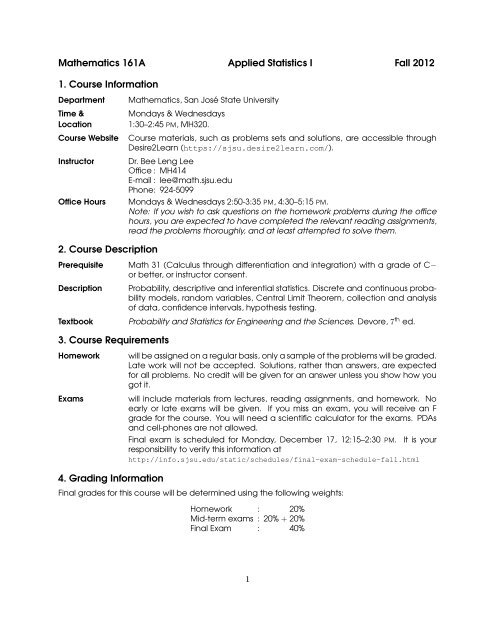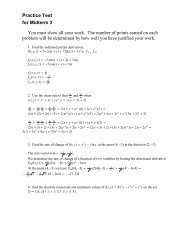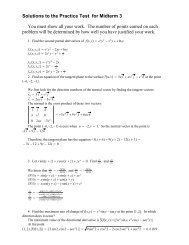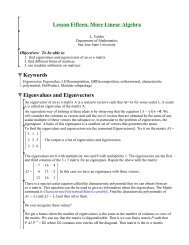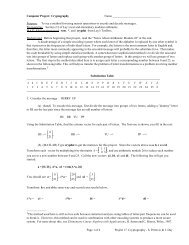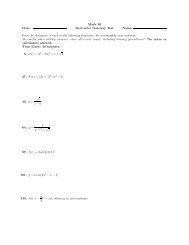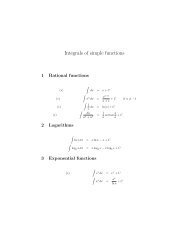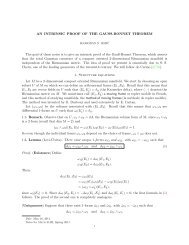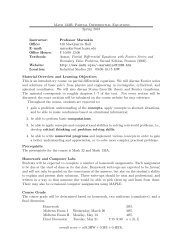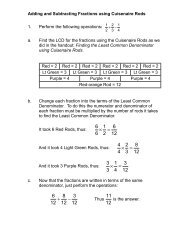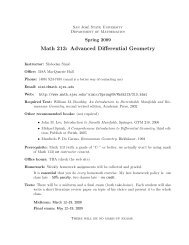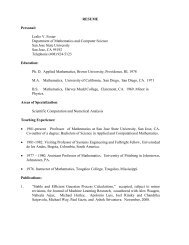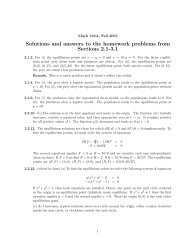Mathematics 161A Applied Statistics I Fall 2012 1. Course ...
Mathematics 161A Applied Statistics I Fall 2012 1. Course ...
Mathematics 161A Applied Statistics I Fall 2012 1. Course ...
Create successful ePaper yourself
Turn your PDF publications into a flip-book with our unique Google optimized e-Paper software.
<strong>Mathematics</strong> <strong>161A</strong> <strong>Applied</strong> <strong>Statistics</strong> I <strong>Fall</strong> <strong>2012</strong><br />
<strong>1.</strong> <strong>Course</strong> Information<br />
Department<br />
Time &<br />
Location<br />
<strong>Course</strong> Website<br />
Instructor<br />
Office Hours<br />
2. <strong>Course</strong> Description<br />
Prerequisite<br />
Description<br />
Textbook<br />
3. <strong>Course</strong> Requirements<br />
Homework<br />
Exams<br />
4. Grading Information<br />
<strong>Mathematics</strong>, San José State University<br />
Mondays & Wednesdays<br />
1:30–2:45 PM, MH320.<br />
<strong>Course</strong> materials, such as problems sets and solutions, are accessible through<br />
Desire2Learn (https://sjsu.desire2learn.com/).<br />
Dr. Bee Leng Lee<br />
Office : MH414<br />
E-mail : lee@math.sjsu.edu<br />
Phone: 924-5099<br />
Mondays & Wednesdays 2:50-3:35 PM, 4:30–5:15 PM.<br />
Note: If you wish to ask questions on the homework problems during the office<br />
hours, you are expected to have completed the relevant reading assignments,<br />
read the problems thoroughly, and at least attempted to solve them.<br />
Math 31 (Calculus through differentiation and integration) with a grade of C−<br />
or better, or instructor consent.<br />
Probability, descriptive and inferential statistics. Discrete and continuous probability<br />
models, random variables, Central Limit Theorem, collection and analysis<br />
of data, confidence intervals, hypothesis testing.<br />
Probability and <strong>Statistics</strong> for Engineering and the Sciences. Devore, 7 th ed.<br />
will be assigned on a regular basis, only a sample of the problems will be graded.<br />
Late work will not be accepted. Solutions, rather than answers, are expected<br />
for all problems. No credit will be given for an answer unless you show how you<br />
got it.<br />
will include materials from lectures, reading assignments, and homework. No<br />
early or late exams will be given. If you miss an exam, you will receive an F<br />
grade for the course. You will need a scientific calculator for the exams. PDAs<br />
and cell-phones are not allowed.<br />
Final exam is scheduled for Monday, December 17, 12:15–2:30 PM. It is your<br />
responsibility to verify this information at<br />
http://info.sjsu.edu/static/schedules/final-exam-schedule-fall.html<br />
Final grades for this course will be determined using the following weights:<br />
Homework : 20%<br />
Mid-term exams : 20% + 20%<br />
Final Exam : 40%<br />
1
5. Tentative Schedule<br />
Topic<br />
Basic Concepts (§ 2.1–2.3): sample spaces and events; axioms, interpretations, and<br />
properties of probability; counting techniques.<br />
Conditional Probability & Independence (§ 2.4–2.5): conditional probability; multiplication<br />
rule, law of total probability, Bayes’ Theorem; independence of events.<br />
Discrete Random Variables (§ 3.1–3.3): random variables, probability mass function,<br />
cumulative distribution function, expectation, variance.<br />
Number of<br />
Lectures<br />
3<br />
3<br />
3<br />
First midterm exam covers § 2.1–3.3.<br />
Special Discrete Distributions (§ 3.4–3.6): Bernoulli trial; binomial (Bernoulli), negative<br />
binomial (geometric), hypergeometric, and Poisson distributions.<br />
Continuous Random Variables (§ 4.1–4.2): probability density function, cumulative<br />
distribution function, expectation, variance, percentile.<br />
Special Continuous Distributions (§ 4.3–4.4): uniform, normal, and gamma distributions.<br />
Second midterm exam covers § 3.1–4.4.<br />
Descriptive <strong>Statistics</strong> (§ <strong>1.</strong>1, <strong>1.</strong>3–<strong>1.</strong>4): population, sample, data; measures of location<br />
and measures of variability.<br />
<strong>Statistics</strong> and Their Distributions (§ 5.3–5.5): random sample, statistic, sampling distribution;<br />
mean and variance of a linear combination of random variables; distribution<br />
of sample mean; central limit theorem.<br />
Point and Interval Estimation (§ 6.1, 7.1–7.4): point estimate/estimator, standard error;<br />
interval estimate/estimator, confidence level, confidence interval; confidence<br />
intervals for the mean of normal distribution; large-sample confidence intervals for<br />
the population mean; confidence intervals for the variance of normal distribution.<br />
Testing Statistical Hypotheses (§ 8.1, 8.2, 8.4): null and alternative hypotheses; onetailed<br />
and two-tailed tests, test statistic, rejection/critical region; type I and type II<br />
errors, and corresponding probabilities, significance level, power; tests for population<br />
mean; p-value.<br />
3<br />
2<br />
3<br />
1<br />
3<br />
3<br />
3<br />
6. University, College, or Department Policy Information<br />
See http://www.sjsu.edu/math/courses/greensheet/<br />
THE CONTENT OF THIS GREENSHEET IS SUBJECT TO CHANGE AND ANY CHANGES WILL BE ANNOUNCED<br />
IN CLASS. IF YOU MISS A CLASS, IT IS YOUR RESPONSIBILITY TO FIND OUT FROM YOUR CLASSMATES<br />
WHAT YOU HAVE MISSED.<br />
2


